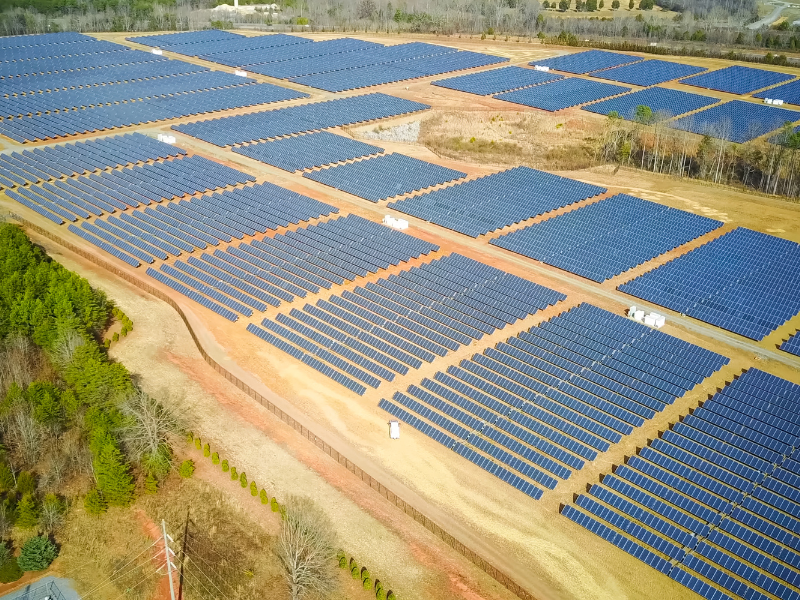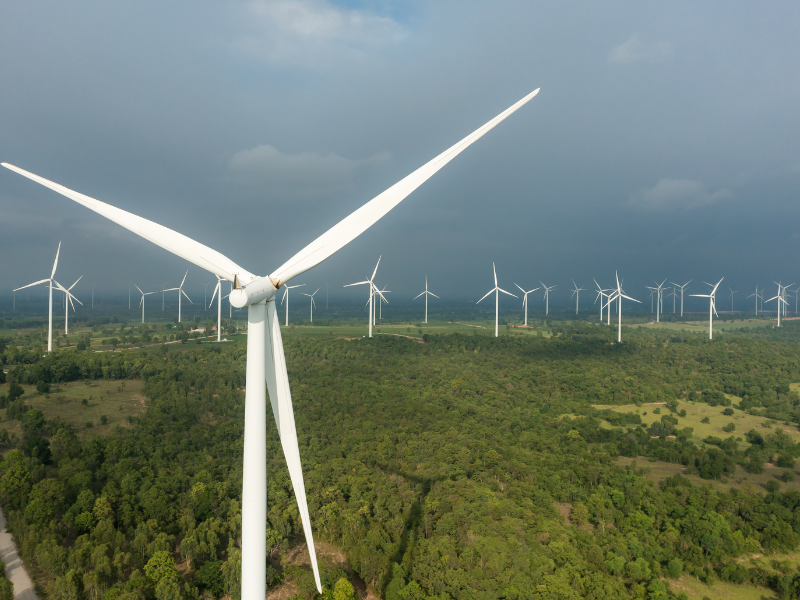In today’s world, the need for sustainable and clean energy sources has never been more crucial. As concerns about climate change and environmental degradation continue to grow, renewable energy sources have emerged as the key solution to reducing carbon emissions and transitioning to a more sustainable energy future.
In this article, we will explore the concept of renewable energy sources in depth, discussing their importance, types, advantages, challenges, government initiatives, and future trends. We will also debunk common myths associated with renewable energy sources and answer frequently asked questions to provide a comprehensive understanding of this vital topic.
What are Renewable Energy Sources?

Renewable energy sources are natural resources that can be replenished or regenerated over time. Unlike traditional fossil fuels, such as coal and oil, which deplete finite resources and contribute to pollution and climate change, renewable energy sources harness abundant and clean sources of energy from nature. These sources include sunlight, wind, water, biomass, and geothermal heat. By utilizing renewable energy sources, we can reduce greenhouse gas emissions, decrease our dependence on non-renewable resources, and mitigate the harmful effects of climate change.
Why are Renewable Energy Sources Important?

The importance of renewable energy sources cannot be overstated. Here are some key reasons why these sources are essential for our planet’s future:
- Climate Change Mitigation: Renewable energy sources play a crucial role in mitigating climate change. Unlike fossil fuels, renewable energy sources produce little to no greenhouse gas emissions during operation. By transitioning to renewables, we can significantly reduce our carbon footprint and limit the negative impacts of climate change.
- Energy Security: Dependence on fossil fuels from foreign countries can create energy security risks. Renewable energy sources, on the other hand, are domestically available and can enhance energy security by diversifying our energy mix. By adopting renewable energy sources, countries can reduce their reliance on imported fuels and strengthen their energy independence.
- Job Creation: The renewable energy sector has emerged as a significant source of employment opportunities. By investing in renewable energy technologies and infrastructure, we can create a vast number of green jobs, stimulating economic growth and promoting sustainable development.
- Environmental Benefits: The use of renewable energy sources helps protect and preserve our natural environment. Unlike fossil fuels, which release harmful pollutants and contribute to air and water pollution, renewable energy sources produce clean energy with minimal environmental impact. This ensures cleaner air, reduces water pollution, and protects biodiversity.
- Sustainable Development: Renewable energy sources contribute to sustainable development by providing access to clean and affordable energy for all. In many developing countries, renewable energy sources offer a viable solution for electrification in remote areas where traditional grid infrastructure is inaccessible. By leveraging renewable energy, we can bridge the energy gap and promote inclusive growth.
Types of Renewable Energy Sources

Solar Energy
Solar energy is the most abundant renewable energy source on Earth. It utilizes the sun’s rays to generate electricity through photovoltaic (PV) panels or concentrated solar power (CSP) systems. Solar energy can be harnessed in various ways, including rooftop solar panels, solar farms, and solar thermal systems. With advancements in solar technology, the cost of solar power has significantly decreased, making it an increasingly popular choice for clean energy generation.
Wind Energy
Wind energy harnesses the power of the wind to generate electricity. Wind turbines, typically found in wind farms on land or offshore, capture the kinetic energy of the wind and convert it into electrical energy. Wind energy is a clean and abundant resource, with the potential to supply a significant portion of the world’s electricity needs. It is a mature and well-established technology that continues to grow rapidly worldwide.
Hydropower
Hydropower, also known as hydroelectric power, utilizes the energy of flowing or falling water to generate electricity. It is one of the oldest and most widely used renewable energy sources. Hydropower plants convert the potential energy of water stored in dams or flowing in rivers into mechanical energy, which is then transformed into electrical energy through generators. Hydropower offers a reliable and flexible source of energy, with large-scale projects providing substantial electricity generation.
Biomass Energy
Biomass energy is derived from organic materials, such as plant matter, agricultural residues, and organic waste. These materials can be burned directly to produce heat or converted into biofuels for transportation and electricity generation. Biomass energy has the advantage of using waste materials that would otherwise be disposed of, reducing waste and providing a sustainable energy source.
Geothermal Energy
Geothermal energy harnesses heat from beneath the Earth’s surface to generate electricity or provide direct heating and cooling. By tapping into geothermal reservoirs, deep wells can be drilled to access hot water or steam, which can then power turbines and generate electricity. Geothermal energy is reliable, available 24/7, and produces low emissions. However, it is limited to areas with accessible geothermal resources, such as geysers, hot springs, or volcanic regions.
Advantages of Renewable Energy Sources

Renewable energy sources offer numerous advantages over conventional fossil fuels. Here are some key benefits:
Environmental Benefits
Renewable energy sources produce little to no greenhouse gas emissions during operation, reducing our carbon footprint and helping combat climate change. They also generate clean energy without significant air or water pollution, minimizing harmful impacts on the environment, human health, and ecosystems.
Economic Benefits
The renewable energy sector fosters economic growth and job creation. Investments in renewable energy technologies and infrastructure stimulate various industries, generating employment opportunities and driving sustainable development. Additionally, the declining costs of renewable energy sources make them increasingly competitive with fossil fuels, improving energy affordability and security.
Energy Security
By diversifying our energy mix and reducing dependence on imported fossil fuels, renewable energy sources enhance energy security. Countries can reduce their vulnerability to price shocks, geopolitical tensions, and supply disruptions, ensuring a reliable and sustainable energy supply.
Job Creation
The renewable energy sector offers vast employment potential. From manufacturing and installation to operation and maintenance, renewable energy projects create jobs across various skill levels. These green jobs contribute to local economies, stimulate innovation, and foster a skilled workforce.
Sustainable Development
Renewable energy sources provide an opportunity for inclusive growth and access to electricity in remote areas. Off-grid renewable energy solutions offer a reliable and cost-effective alternative to traditional grid infrastructure, powering homes, schools, and healthcare facilities in underserved communities. By promoting sustainable development, renewable energy can uplift communities and improve quality of life.
Challenges in Harnessing Renewable Energy Sources
While renewable energy sources offer immense potential, there are several challenges to overcome for their widespread adoption. These challenges include:
Intermittency
One of the primary challenges associated with renewable energy sources is their intermittent nature. Solar energy depends on sunlight, which is not available during the night or inclement weather. Wind energy relies on wind speeds, which can vary throughout the day and across seasons. These fluctuations pose challenges for grid integration and require effective energy storage solutions to ensure a stable and reliable energy supply.
Storage
Energy storage is crucial for overcoming the intermittent nature of renewable energy sources. Effective storage solutions, such as batteries and pumped hydro storage, can store excess energy during periods of high generation and release it during times of low generation. However, energy storage technologies are still evolving and need further advancements to provide cost-effective, scalable, and sustainable solutions.
Infrastructure
The widespread adoption of renewable energy sources requires significant infrastructure development. This includes building solar and wind farms, expanding transmission and distribution grids, and integrating renewable energy into existing systems. Infrastructure challenges include land requirements, permitting processes, grid integration, and ensuring reliable interconnections between renewable energy sources and end consumers.
Cost
While the cost of renewable energy has decreased significantly over the years, it still presents a barrier to widespread adoption. Initial investment costs for renewable energy projects can be higher than conventional fossil fuel-based projects. However, the long-term benefits, such as reduced fuel costs and environmental externalities, make renewable energy cost-competitive in the long run.
Public Acceptance
Public acceptance and support are crucial for the successful deployment of renewable energy projects. Some communities may have concerns about the visual impact of wind turbines or solar panels, noise levels, or potential disruptions to local ecosystems. Effective communication, community engagement, and addressing these concerns through responsible planning and design are key to gaining public acceptance.
Government Initiatives and Policies for Renewable Energy Sources
Governments worldwide play a pivotal role in promoting the adoption of renewable energy sources through various initiatives and policies. Here are some examples of government actions:
- Renewable Portfolio Standards (RPS): Many countries and states have implemented RPS, requiring a certain percentage of electricity generation to come from renewable sources. These standards incentivize utilities and power producers to invest in renewable energy projects and increase their renewable energy capacity.
- Feed-in Tariffs (FIT): FIT programs ensure that renewable energy producers receive a guaranteed payment for every unit of electricity generated. This incentivizes the development of renewable energy projects by providing long-term contracts and stable investment returns.
- Tax Incentives: Governments offer tax incentives, grants, and subsidies to promote the development and deployment of renewable energy technologies. These incentives reduce the financial burden on renewable energy projects, making them more economically viable and attractive to investors.
- Research and Development (R&D) Funding: Governments invest in R&D to drive innovation, improve renewable energy technologies, and reduce costs. Public funding supports research institutions and private companies in developing breakthroughs in solar, wind, energy storage, and other renewable energy fields.
- International Agreements: International agreements, such as the Paris Agreement, commit countries to reduce their greenhouse gas emissions and transition to sustainable energy systems. These agreements foster collaboration, knowledge sharing, and financial support for renewable energy projects.
Future Trends in Renewable Energy Sources
The future of renewable energy sources looks promising, with several trends shaping the industry. Here are some notable trends:
- Technological Advancements: Continued advancements in renewable energy technologies, such as more efficient solar panels, larger wind turbines, and improved energy storage, will drive down costs and increase energy production capacities. Innovations like perovskite solar cells, floating wind farms, and next-generation batteries hold the potential to revolutionize the industry.
- Decentralization and Distributed Generation: Peer-to-peer energy trading, microgrids, and distributed generation models are gaining popularity. These models allow individuals and communities to generate, consume, store, and trade energy locally, reducing reliance on centralized power grids and fostering energy independence.
- Electrification of Transportation: The transportation sector is undergoing a transformation with the electrification of vehicles. The growing adoption of electric vehicles (EVs) is driving the demand for renewable energy sources to power these vehicles. This presents new opportunities for integrating transportation and renewable energy systems.
- Hydrogen Economy: Hydrogen is emerging as a potential energy carrier for sectors with challenging decarbonization, such as heavy industry and long-haul transportation. Renewable hydrogen production, through electrolysis powered by renewable energy sources, can facilitate the development of a hydrogen economy.
- Smart Grids and Energy Management: The integration of renewable energy sources necessitates smart grid technologies and advanced energy management systems. These technologies enable real-time monitoring, demand response, and optimization of energy flows, enhancing grid stability and flexibility.
Myth Debunking: Misconceptions about Renewable Energy Sources
There are several misconceptions about renewable energy sources that need to be addressed. Let’s debunk some common myths:
Myth 1: “Renewable Energy Sources are Expensive” Contrary to popular belief, the cost of renewable energy has significantly decreased over the years. Technological advancements, economies of scale, and supportive policies have made solar and wind energy cost-competitive with fossil fuels in many regions. Furthermore, the long-term benefits, such as reduced operational costs and environmental externalities, make renewable energy a cost-effective choice.
Myth 2: “Renewable Energy Sources Can’t Meet Our Energy Demands” Renewable energy sources have the potential to meet a substantial portion of our energy demands. With advancements in technology, the efficiency and capacity of renewable energy systems continue to increase. Additionally, renewable energy can be combined with energy storage solutions and diversified across multiple sources to ensure a reliable and resilient energy supply.
Myth 3: “Renewable Energy Sources are Unreliable” Intermittency, a common concern associated with renewable energy, can be effectively managed through energy storage, grid integration, and demand response mechanisms. Furthermore, advanced forecasting and predictive technologies enable better planning and utilization of renewable energy, ensuring its reliability and integration into the existing energy infrastructure.
Myth 4: “Renewable Energy Sources Cause Grid Instability” While the integration of renewable energy sources presents grid management challenges, these challenges can be addressed through smart grid technologies, energy storage, and grid optimization. Grid operators and utilities are developing innovative solutions to maintain grid stability and balance supply and demand with the growing presence of renewable energy.
Myth 5: “Renewable Energy Sources Have Negative Environmental Impacts” Renewable energy sources are a cleaner and more sustainable alternative to fossil fuels. While there may be some environmental impacts associated with the production and disposal of renewable energy technologies, such as the manufacturing of solar panels or wind turbine blades, these impacts are minimal compared to the pollution, ecological destruction, and climate change caused by fossil fuels.
Frequently Asked Questions
How can I switch to renewable energy sources at home?
Transitioning to renewable energy at home can be done in several ways. Installing solar panels on your roof or joining a community solar program allows you to generate your own clean electricity. You can also switch to a renewable energy supplier that sources its electricity from wind, solar, or other renewable sources. Additionally, reducing energy consumption through energy-efficient appliances, insulation, and smart home technologies further complements your switch to renewable energy.
Are renewable energy sources available everywhere?
Yes, renewable energy sources are available virtually everywhere. The availability and potential for harnessing specific renewable energy sources may vary depending on geographical location and environmental conditions. Solar energy is abundant in areas with ample sunlight, wind energy is favorable in regions with consistent wind patterns, and hydropower depends on suitable water resources. However, technological advancements and innovation are continually expanding the reach of renewable energy sources.
How does the cost of renewable energy sources compare to fossil fuels?
The cost of renewable energy has been steadily declining and is now competitive with or cheaper than fossil fuels in many regions. Factors such as technological advancements, economies of scale, and supportive policies have contributed to this cost reduction. Additionally, the long-term benefits and externalities associated with renewable energy, such as reduced fuel costs, environmental impact, and health benefits, make it a more economically viable and sustainable choice.
Can renewable energy sources help mitigate climate change?
Absolutely! Renewable energy sources play a critical role in mitigating climate change. By replacing fossil fuels with clean and renewable energy sources, we can significantly reduce greenhouse gas emissions, the primary drivers of climate change. Renewable energy also helps diversify our energy mix, decrease our dependence on finite resources, and promote a more sustainable and resilient energy future.
Conclusion
Renewable energy sources are at the forefront of the global transition to a more sustainable and clean energy future. With their numerous advantages, including environmental benefits, economic growth, energy security, job creation, and sustainable development, renewable energy sources offer a compelling solution to our current energy and climate challenges. While challenges and misconceptions persist, supportive policies, technological advancements, and public awareness are driving the adoption of renewable energy sources worldwide.
By harnessing the power of the sun, wind, water, biomass, and geothermal heat, we can pave the way for a more sustainable, prosperous, and resilient planet. Let us embrace renewable energy sources and shape a brighter future for generations to come.




